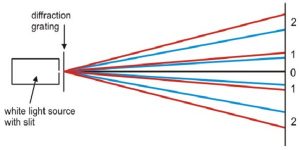What Is Diffraction Grating ?

A diffraction grating is made by making many parallel scratches on the surface of a flat piece of some transparent material. A diffraction grating disperses a beam of various wavelengths into a spectrum of associated lines on basis of the principle of diffraction; in any particular direction, only those waves of a given wavelength will be conserved, all the rest being destroyed because of interference with one another. Gratings give exceptionally high resolutions of spectral lines.
When there is a need to separate light of different wavelengths with high resolution, then a diffraction grating is used. This “super prism” aspect of the diffraction grating leads to application for measuring atomic spectra in both laboratory instruments and telescopes. A large number of parallel, closely spaced slits constitutes a diffraction grating. The condition for maximum intensity is the same as that for the double slit or multiple slits, but with a large number of slits the intensity maximum is very sharp and narrow, providing the high resolution for spectroscopic applications
Diffraction gratings are commonly used for spectroscopic dispersion and analysis of light. What makes them particularly useful is the fact that they form a sharper pattern than double slits do. That is, their bright fringes are narrower and brighter while their dark regions are darker. Diffraction gratings are key components of monochromators used, for example, in optical imaging of particular wavelengths from biological or medical samples. A diffraction grating can be chosen to specifically analyse a wavelength emitted by molecules in diseased cells in a biopsy sample or to help excite strategic molecules in the sample with a selected wavelength of light. Another vital use is in optical fibre technologies where fibres are designed to provide optimum performance at specific wavelengths. A range of diffraction gratings are available for selecting wavelengths for such use.
DIFFRACTION GRATING EQUATION:
Consider two rays that emerge making the angle θ with the straight through the line. Constructive interference will occur if the difference in their two path lengths is an integral multiple of their wavelength λ i.e.,
Now, n λ=dsin(θ)
where n = 1, 2, 3, …
This is known as the DIFFRACTION GRATING EQUATION.
In this formula, θ is the angle of emergence at which a wavelength will be bright. Also, d is the distance between slits. Obviously,
d = 1N, where N is the grating constant, and it is the number of lines per unit length. Also, n is the order of grating, which is a positive integer, representing the repetition of the spectrum.
